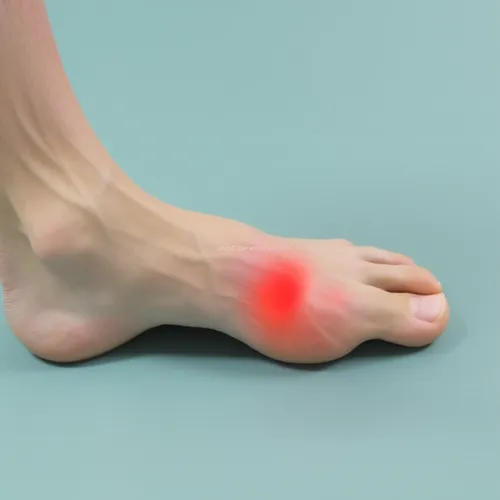About Gout
There are many who scratch their heads and think “I thought Gout was the name of various ailments back in colonial times and even further back then that?” They never believed that gout is actually a condition that still happens today. Ben Franklin used to walk on crutches due to gout and constantly complained about one of his toes causing immense pain.
Gout is a very painful form of arthritis that can attack both small and large joints. Usually, it only attacks one joint at a time and usually starts off by attacking the large toe. Other joints such as fingers, ankles, wrists, knees and elbows can also be affected.
Gout has been around through all of history and has been referred to as “the disease of kings” because gout usually affected those who drank a great deal of alcohol or were over fed.
This condition does seem to affect males more than females and usually surfaces after the age of 40. Women that are affected by gout usually get this affliction after menopause.
The Causes of Gout
Gout develops from high levels of uric acid in the blood stream. Uric acid is produced when there is a breakdown of purines which are found in certain foods and/or formed by the body. Purines are a white crystalline group of compounds including uric acid, zanthine and caffeine.
Once developed, uric acid is carried through your blood and passes through your kidneys and then filters out into your urine. This can cause attacks of gout which is formed by kidney stones.
Uric acid can also form by the breakdown of your body’s tissues including blood cells. Normally, uric acid is removed from the body by the kidneys and taken away through urine. Unfortunately, uric acid levels can become too high if the kidneys cannot rid of this acid fast enough, either through healthy issues or due to inherited tendencies. Uric acid will also have higher levels if you suffer from kidney disease.
When uric acid builds up in your bloodstream it flows over and forms sharp crystals that collect in the joints and soft tissues, ergo — arthritis. That said, the majority of people who suffer from high levels of uric acid do not develop gout.
The Symptoms of Gout
If you get an attack of gout, the pain can be very intense and usually takes place during the night hours. The joint that is attacked swells and your skin turns a reddish/purple colour and is very hot to the touch. You may also develop a fever and loss of appetite. The joint pain can become so painful, that merely touching the affected joint can be agonising.
Should someone suffer from gout, for a long period of time, these crystals will collect in other soft tissues throughout your body, including hands, fingers, wrists, elbows and earlobes. There is a formation of small, hard bumps that look like white pimples. These bumps are called tophi are visible underneath your skin.
The initial attack usually clears up within a few days but on some rare occasions can last for weeks.
The Risks of Someone Getting Gout
Again, this is caused by high levels of uric acid and the risks can be caused by the following:
- Consuming large amounts of alcohol, especially wine and beer.
- Being overweight.
- Having major surgery or a sever and sudden illness.
- Taking certain medications such as diuretics for heart disease or high blood pressure.
- Diets consisting of food products that are high in uric acids such as some sea foods, liver and kidneys.
- A family history of high levels of uric acid.
How to Prevent Gout
- Eat a healthy diet and cut back on alcoholic consumption. Get regular exercise in order to prevent weight gain.
- Reduce your intake of purine-rich foods such as meat, organ meats, seafood, and beans. Instead, opt for low-purine foods like fruits, vegetables, whole grains, and low-fat dairy products.
- Drink plenty of water to help flush excess uric acid from your body. Aim for at least eight glasses per day.
- Limit your intake of high-fructose corn syrup, found in sugary drinks and processed foods, as it has been linked to an increased risk of gout.
- Talk to your doctor about medications that can help lower uric acid levels or prevent gout attacks, such as allopurinol or colchicine.
- Avoid crash diets or fasting, as they can cause a sudden increase in uric acid levels and trigger a gout attack.
The Diagnosis of Gout
Your doctor will study your medical history and examine the affected area or joint. He or she will take a urine sample and look for high levels of uric acid, although, high levels do not mean you have gout.
In order to confirm and diagnosis, your doctor will probably take a fluid sample from the affected area or from a lump that has formed under your skin. This again, is looking for levels of uric acid crystals and is performed under a microscope. Your doctor, at some point, might want you to undergo an x-ray of the affected area as well.
Treating Gout
The good news is, gout is one of the easiest forms of arthritis to treat and can be treated in two ways. During an attack, you will given a treatment of non-steroidal anti-inflammatory drugs to relieve the pain and reduce the inflammation. With proper treatment, the attack can be brought under control within 24 hrs. You will also be given these drugs to keep at home in order to immediately start treatment at the first sign of any further attacks.
Should you get frequent attacks of gout, you will be given medications that will prevent further occurrences.
Lifestyle Changes to Manage Gout
While medication plays a crucial role in treating gout, making certain lifestyle changes can significantly reduce the frequency and severity of attacks:
- Stay hydrated: Drink 8-10 glasses of water daily to help flush out uric acid.
- Maintain a healthy weight: Excess weight puts more stress on your joints and can increase uric acid levels.
- Exercise regularly: Low-impact activities like swimming or cycling can help manage weight and improve joint health.
- Limit alcohol: Beer and spirits are particularly problematic for gout sufferers.
- Watch your diet: Cut back on red meat, organ meats, and high-fructose corn syrup.
- Choose wisely: Opt for low-fat dairy, whole grains, and vegetables.
- Consider cherries: Some studies suggest cherries may help reduce gout attacks.
By combining these lifestyle tweaks with proper medical care, you’ll be better equipped to keep gout at bay and enjoy a more comfortable, active life.
Photo by Zoom Health
Zoom Health is a leading UK supplier of Home Health Tests and Earplugs





